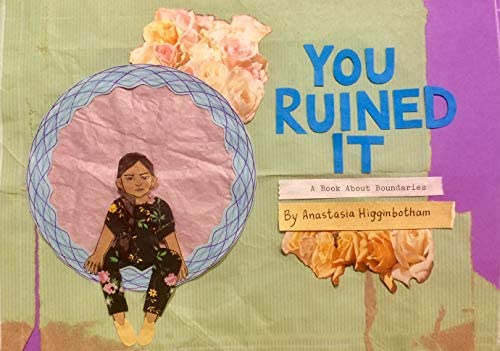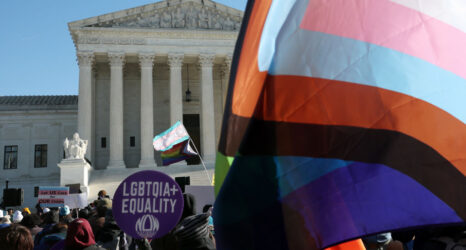“Families do not have to be sites of violence, hierarchy and domination. They can be the first place a child experiences justice, equity and wholeness.”

As a young child growing up in small-town Pennsylvania, author Anastasia Higginbotham discovered the power of creating art and writing stories. These pastimes, she told Ms., gave her a way to organize both her thoughts and her feelings. “It’s how I studied for a math or history test,” she explains. “It’s also how I processed death.”
Higginbotham has carried this MO into adulthood and her award-winning children’s books have helped diverse kids parse a host of tough subjects: parental divorce, homophobia, heterosexism, transphobia, racism, sex, sexuality and the lies of white supremacy among them. Her latest book, You Ruined It, tackles familial incest and is by turns personally revealing, reassuring and full of practical insight into handling abuse. Clear-eyed yet unsparing in its critique, the text introduced 11-year-old Dawn, her older sibling, Billie, and their mom, and includes Higginbotham’s gorgeous collages, many with hand-drawn features that bring the characters into focus. The result is gripping, relatable and important.
Higginbotham spoke to reporter Eleanor J. Bader about You Ruined It, the sixth book in her Ordinary Terrible Things series.
Eleanor J. Bader: Let’s start by talking about your art. What’s your process for creating collages?
Anastasia Higginbotham: I spend a lot of time thinking about the backgrounds and characters I want to create before I cut anything out of a magazine or catalog. I want the impact to be visceral and emotional. I lay pieces next to each other and move them around for a while before I glue.
I collect images all the time. If I’m walking and see a pile of magazines being thrown out, I often stop for them. Once, I found a stack of home décor magazines from the 1980s and knew I’d be able to use them to recreate my entire childhood if I wanted to.
You Ruined It utilizes my drawing style from when I was a kid and takes it to the farthest reaches of my ability today. Part of the credit goes to Dottir Press art director Drew Stevens. He was a close collaborator and made a lot of beautiful choices for the book.

Bader: The book is fiction, yet it draws on your experiences and those of other incest survivors. What were your goals for telling this story?
Higginbotham: I come from a loving, but patriarchal Catholic family. Sexual attention from grown men and sexual jealousy from grown women are as familiar to me as my own name. From a young age, I related to rape as inevitable, a constant threat, something I could cause to happen to me by being too nice or too sexy.
I want readers to understand that childhood sexual abuse, even the subtle and insidious kind, has a lifelong impact. I want kids to know it is not their responsibility to stop or prevent it. It is the responsibility of the ones violating them to not do it. I also mean to expose the fact that the crisis of disclosure—telling someone—may be followed by more and worse crises. Will they believe you, accuse you of causing it, make excuses for it, violently attack the abuser?
Bader: Why did you include the character of Angeliska, a self-proclaimed witch?
Higginbotham: I put her there to undermine patriarchy and all the Father/God religions. Angeliska is [the] only real person in this book. I met her while taking a weeklong workshop taught by writer-comic-professor Lynda Barry years ago. I wrote her as the girlfriend of Dawn’s older sibling Billie (Billie is genderqueer) so Dawn would have an ally from outside the family, someone who is magical and a healer in the ancient goddess and nature-worship traditions. The real Angeliska is all of this and more.
I want readers to understand that childhood sexual abuse, even the subtle and insidious kind, has a lifelong impact. I want kids to know it is not their responsibility to stop or prevent it. It is the responsibility of the ones violating them to not do it.
Bader: Dawn’s decision to tell her mother and Billie about the abuse requires courage and fortitude, and she is lucky to get the support she needs from them when she reveals what happened. But telling is still a source of tension as well as relief for her. Is this common?
Higginbotham: Ultimately, You Ruined It is about loss. Dawn has to give up something precious in order to acknowledge and name what happened. She can no longer go to the nearby creek with her 22-year-old cousin, something she loved doing before he abused her trust. In fact, she has to give up her relationship with him altogether. In addition, when she tells her family what her cousin did, she feels as if she is betraying him. She is confused and the impact of her confession is not as clear cut to her as it is to those around her. Her mother tells her that she has to stop seeing him and she’s totally thrown by that. Why can’t it go back to what it was before, she wonders?
In the end, Dawn’s story is about being able to bear this loss and survive. She still loves her cousin. She misses him. I hope readers will empathize with her since most of us know how it feels to have to leave a relationship that was not supposed to go bad, but did. I allow Dawn to grieve this.
Bader: How will Dawn’s confession impact the long-term cohesion of her family?
Higginbotham: There’s a poem about loss by David Whyte that has the line: “The blade is so sharp—It cuts things together—not apart.” That’s what I was going for with the mom, Billie and Dawn.
Each member of the household has experienced being disbelieved and disregarded due to gender and patriarchal structure. They’re all living within rape culture.
Although neither Billie nor their mom blame Dawn for what happened, she blames herself. In addition, her mom feels guilty for not protecting her daughter so blame is in the air. Still, I wanted the mom to do a beautiful job in supporting her child. I wanted her to be really intentional in how she handled it, registering to take a self-defense class so that she can feel steadier when she says: “This stops now in this family. THIS STOPS NOW.”
Changing a family dynamic is never easy and even though this family is struggling, they’re struggling together. I offer no platitudes about things being okay in the end. That is not something I can promise.
Bader: The idea of retribution is a key aspect of how incest and abuse are typically handled. You opt not to have Dawn file a police report. Can you say more about this decision?
Higginbotham: Dawn does not want her cousin to go to jail. I wrote it this way because I know that calling in law enforcement can bring more harm than good to Dawn and her cousin.
Billie, though, wants to make sure that their cousin never does this to anyone else and expresses the part of me that says, ‘let’s get him’ even though I know that this will not improve anything. Still, Billie is hurt by being unable to protect Dawn. Billie’s pain is very real to me.
Restorative or transformative justice models are a way to make progress on this matter of not wanting to report.
Bader: Tell me about why the cousin, who you never name, is in the military.
Higginbotham: I want to show that his service may have harmed him. I want him to be viewed with compassion. Like Dawn and her mom and Billie, he had to contend with a toxic patriarchal environment, too, and now that he is back home, he has a lot of time on his hands and is processing—or maybe he is unable to process—whatever he experienced as a soldier.
Bader: Are Restorative/Transformative Justice programs widespread or are there other ways we can encourage abusers to take responsibility for the harm they cause?
Higginbotham: These efforts are just emerging and deserve our support. But let me tell you a story. Years ago, when I first got on Facebook, I dreaded that I would suddenly be in full view of exes or people [with] who I had weird, bad history. From my first post, it took about 20 minutes for a message to appear from someone who’d molested me when I was 12. He saw my name because we are still in each other’s orbit. This man apologized, acknowledged what he’d done, and told me he’d thought about it for 30 years. He said he was sorry and regretful about what happened. I was ready for it. I finally had the chance to tell him how scared I’d been that night.
After this exchange, what had been a knot of pain and fear in me dissolved. Forgiveness was easy. We’ve been in regular contact ever since. You can unstick trauma if there is a ‘now,’ an honest present, you can step into.
You can unstick trauma if there is a ‘now,’ an honest present, you can step into
Bader: You also took self-defense classes, something Dawn’s mom chooses to do, as well.
Higginbotham: Self-defense has been key for me in holding people accountable, including myself. I began taking classes in 2000, when I was 29, at Prepare Inc. and later became an instructor. Most of us are getting attacked by men we know—family, friends, coworkers, classmates, boyfriends, exes.
If we were better able to name an attempted rape as it’s happening—to say: ‘if you continue, this is rape’ — and were more prepared to use clear, direct language and cause pain to deter an attack, I think we would end a lot of sexual violence on the spot. Having the presence of mind and body to do something in the moment is power. If we can learn how to stay in our bodies, rather than dissociate, we’re better able to interrupt someone who believes they are entitled to take what they want from us. Physical pain is a strong deterrent.
Bader: Many abuse survivors dissociate—mentally removing themselves from an abusive situation—as a coping mechanism. Dawn certainly does this.
Higginbotham: Many abuse survivors will recognize this. When I get emotionally overwhelmed, I still dissociate. My body feels like it is moving off the ground. I wanted to show this happening to Dawn, and the words and images to describe it came easily as I worked.
Learning how to bring yourself back to your body takes practice, but it is something that Dawn and the rest of us can learn to do.
If we were better able to name an attempted rape as it’s happening—to say: ‘If you continue, this is rape’—and were more prepared to use clear, direct language and cause pain to deter an attack, I think we would end a lot of sexual violence on the spot.
Bader: Another topic that the book tackles, albeit briefly, is the way some women—in this case, Gramma—side with abusers by disbelieving victims.
Higginbotham: Dawn’s maternal grandmother is enabling the men in the family to behave badly. This reality causes Dawn to lose her grandmother, too. It was important to me to not have everyone in the family rally around Dawn.
We have to ask ourselves, as parents and people who work with children and teens: Are we modeling for children their right to bodily autonomy? Can they draw boundaries when being asked to give or receive affection? Are the rules different for boys and girls? That’s partly why Billie is who Billie is—not bound by gender.
Bader: You write at the end of the book that “incest is practically unheard of in families where parents share a mutual and equal position of authority, where feelings and opinions are aired openly in an atmosphere of trust, where children are respected, and where there are no secrets.” It sounds utopian.
Higginbotham: These words are from Carolyn M. Byerly, author of The Mother’s Book: How to Survive the Incest of Your Child. I think rooting the patriarchy out of ourselves is similar to white people’s efforts to root out white supremacy. Both require noticing the power dynamics and imbalances in the moment and in the structures.
We all need to be more deliberate, more attentive to the ways racism, patriarchy and sexism have been ingrained in us and then transform ourselves. Families do not have to be sites of violence, hierarchy and domination. They can be the first place a child experiences justice, equity and wholeness.
Up next:





